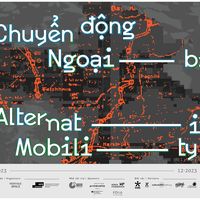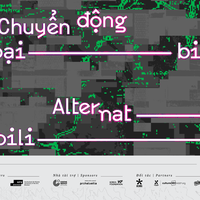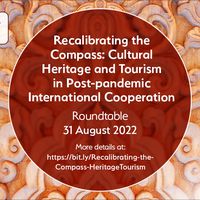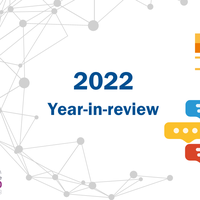Key highlights of Asia-Europe creative encounters in 2023
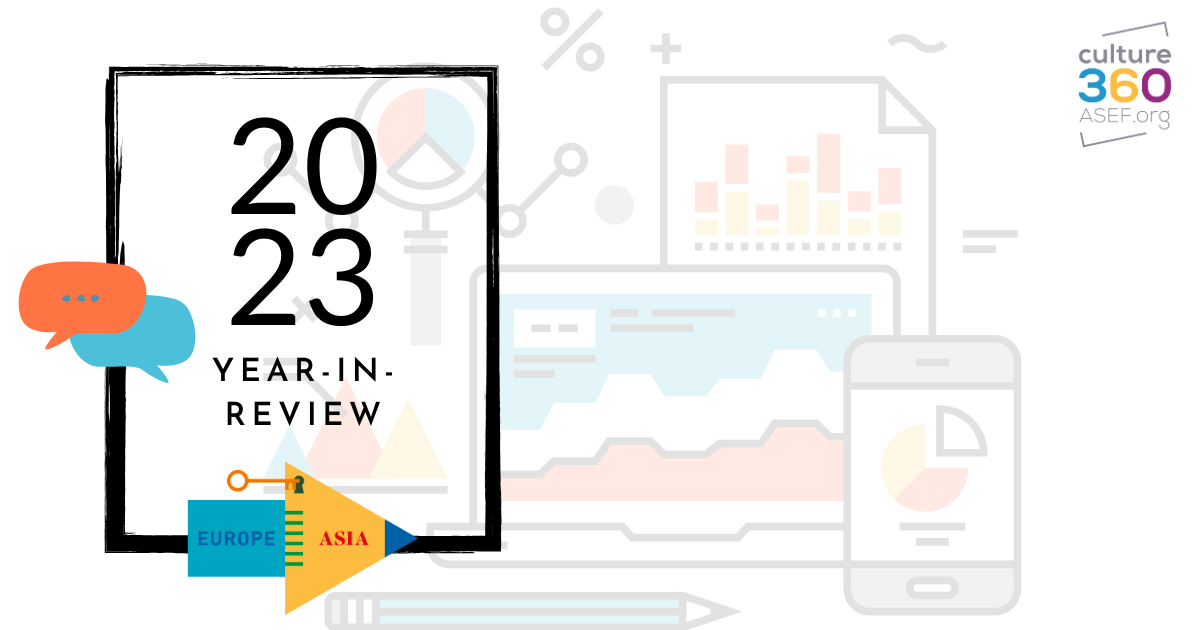
What happened in the culture field between Asia and Europe in 2023? What were some of the opportunities that helped to connect artists and arts managers? As a platform that publishes information, facilitates dialogue and stimulates reflection on the arts and culture of the two regions, we have a few ideas!
Over the year, ASEF culture 360 published 243 news, events and opportunities from Asia and Europe, which included almost 250 opportunities (60% of the total website content). The top 10 ASEM countries were Singapore, Viet Nam, Thailand, the United Kingdom, Germany, Italy, Indonesia, Korea, Cambodia and Malaysia.
Visual arts were the most represented artform, followed by performing arts, and new media and film. The themes were quite equally distributed, although there was slightly more content related to the creative industries, cultural relations, economy and society and art and environment, professional development, culture and development and cultural policy.
A total of 26% of the opportunities were for residencies, 15% for grants and 4% for jobs, and the remainder were general open calls. In terms of regions, 23% of content on the website in 2023 was related to Asia, 20% related to Europe and 14% connected the two regions (the rest consisted of content that was also open to, or was related to, a wider international public).
Connecting Asia and Europe
As always, ASEF culture360 tried to focus on news that specifically connects Asia and Europe and of the 88 items that connected the two regions, there were 21 events, 20 magazine articles, 13 news items, and 33 opportunities, as well as 1 publication.
A trend worth noting in the Asia-Europe opportunities is that they often connected two countries through a residency programme (such as the Gasworks residency for artists based in Pakistan, the Artist-in-Residence programme for artists from Japan at the Cité Internationale des Arts in central Paris, the Artist Designer in Residence programme (ADIR) in Indonesia for French designers, the Malaysia–Germany Artist in Residence Exchange Programme, or the Toji Cultural Foundation residency for writers based in Spain) or a laboratory or professional development programme (such as the Floating EKA artistic laboratory in Poland, the NCW Emerging Translator Mentorships in the UK, or the British Council South Asia Festivals and Culture Academy).

1. British Council South Asia Festivals and Culture Academy
Some projects worth highlighting include the Studio Residencies for Southeast Asian Artists in the European Union, with a final exhibition in Singapore. As part of the SEA AiR programme, artists Priyageetha Dia (Singapore), Ngoc Nau (Vietnam) and Saroot Supasuthivech (Thailand) each undertook 3-month long residencies in Europe (in the Netherlands, Lithuania, and Germany). Bringing back their experiences from diverse contexts in the EU to Singapore, the exhibition Passages speaks of the artists’ journeys across geographical and cultural boundaries from one continent to another; the cultural exchanges that take place during this time; and the continuous development of ideas as they return to their home countries to create new works for the exhibition.
The format of the project – supporting artists over long cycles of exchange and production – is an interesting model that acknowledges the time needed to undertake meaningful intercultural exchange.
Another interesting project is the Month of Art Practice (MAP), an annual international exchange project dedicated to promoting contemporary art initiated and has been organised by Heritage Space in Hanoi, Viet Nam since 2015. The project culminated in an exhibition titled "The Alternative Mobility", a collaboration between Hochschule für Künste Bremen in Germany and Heritage Space and part of the BMBF Collaborative Research Project Bremen Goes Sustainable – BreGoS. As part of MAP 2023, a group of international artists and curators worked together with local artists and students at both Hanoi and Bremen. The results of MAP 2023 were shown in parallel in Bremen, Germany and Hanoi, Viet Nam in two exhibitions at the end of November 2023, featuring works by artists and students from Germany, Japan, Korea, Switzerland, the United Kingdom, and Viet Nam. This project was more than an exchange of exhibitions, rather it was a partnership that sought to foster balanced exchange. As Nguyen Anh Tuan from MAP explained in an article for Insights:
“[MAP] aimed to create a school where there are no teachers and no students, all artists participate equally as colleagues. They will exchange and learn together. They will work side by side in the same space, sharing the same topics and stay in the same living and working conditions. Young Vietnamese artists will receive specific knowledge about contemporary art in the world, and they will gain practical lessons about the responsibilities and attitudes of artists today. Artists from other countries receive new experiences in working and living in conditions that’re not their own, and with inevitable cultural conflicts.”

2. Month of Art Practice (MAP) talk for the public © Heritage Space
It is these spaces of risk-taking and structured exploration that have the potential to create a space for life-changing exchange.
The Insights section of the website has long been the place to dig deeper into case studies, good practices, and insights into the two regions. Of the 34 articles published, over 40% of them directly connected Asia and Europe. This section of the website is commissioned from ASEF cultural programmes and open calls, and it is particularly focused on regions or topics that are not covered in other media.
The Asia-Europe Foundation uniquely placed to connect the regions
The Culture Department of the Asia-Europe Foundation is uniquely placed to develop connections between the two regions. In one of the flagship projects in 2023, ASEF culture360 published Recalibrating the Compass: New Approaches to Asia-Europe Cultural Relations, a new publication presenting the key findings and recommendations that emerged from the Recalibrating the Compass roundtable series.
The series of 5 closed-door roundtables facilitated conversations on pressing themes for the arts and culture communities in Asia and Europe with a view to designing a new, more resilient, and participatory approach for the future, and this publication is a summary of these important conversations.
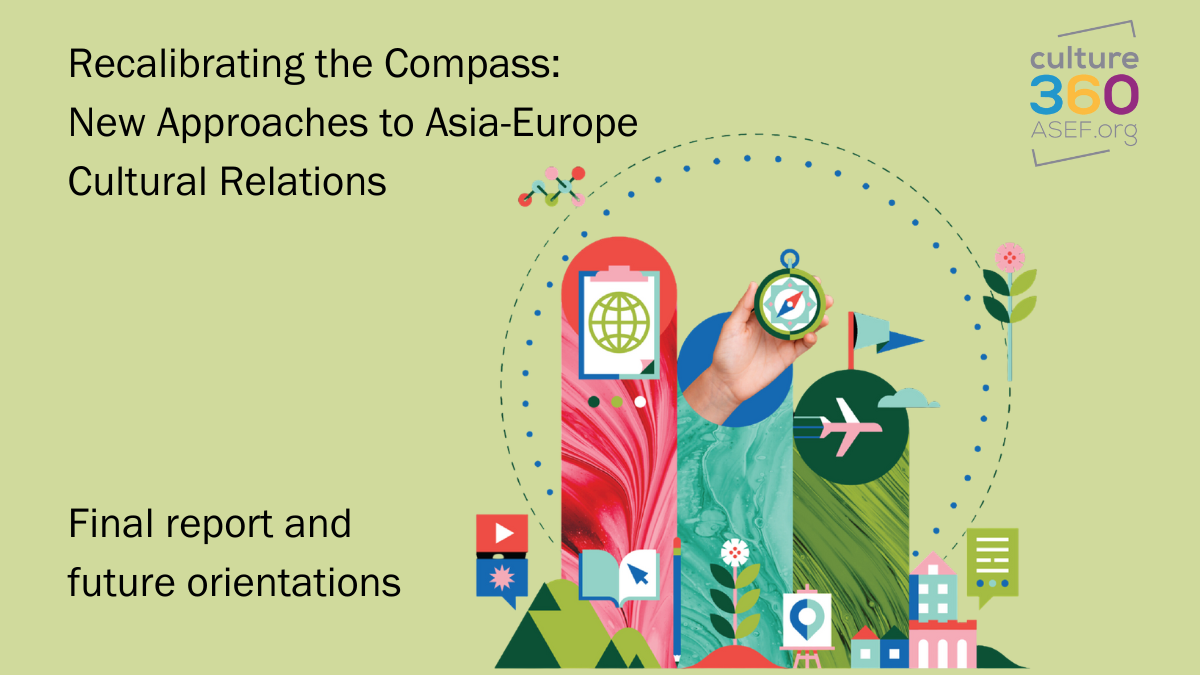
3. Recalibrating the Compass: New Approaches to Asia-Europe Cultural Relations © Asia-Europe Foundation 2023
The Culture Department also launched the Arts Journalism Matters Fellowship 2.0, in collaboration with the European network on cultural management and policy (ENCATC). After a successful pilot in 2021 titled, Virtual Crossovers, 2 emerging arts journalists from Asia and Europe were brought together for a 1-month virtual residency and mentorship programme, with the objective of writing a piece on the topic of cultural diplomacy between Asia and Europe. Following from the residency, both journalists put to practice skills and knowledge gained from their 4-week virtual residency, to cover ASEF LinkUp | Asia-Europe Cultural Diplomacy Lab in Singapore.
They also continued their media partnerships, which, since 2012, has seen ASEF culture360 support over 65 arts events in Asia and Europe. Some partnerships in 2023 have included ResArtis, ArtJakarta, Month of Art Practice, Stateless Mind #5 - Calling it Home, Biennale Jogja 17, Oriente Occidente Dance Festival, Eco Film Lab in Bangladesh, and Bangkok International Performing Arts Meeting 2023.
An exciting initiative in 2023 was the Asia-Europe Cultural Festival Podcast series, which saw conversations between organisers, partners, and participants from Asia and Europe, including Singapore-based storyteller Kamini Ramachandran, musician Vignesh Melwani about his experience being a child of Indian heritage but growing up in Barcelona, Spain, and Cambodia-based French documentary filmmaker, Xavier de Lauzanne about his new film, 'The Perfect Motion' on the history of Cambodian National Royal Ballet. The Podcast builds on ASEF culture360’s working bringing together diverse voices.

4. Asia-Europe Cultural Festival Podcast series featuring Singapore-based storyteller Kamini Ramachandran © Asia-Europe Foundation 2023
The Podcast was part of ASEF’s Asia-Europe Cultural Festival, a public arts festival that celebrates the artistic diversity of Asia and Europe and promotes the dialogue and exchange amongst artists from Asia and Europe. The 2023 edition, held in ASEF’s base of Singapore, presented events spanning dance, film, photography and music by artists from many countries such as Italy, Malaysia, Cambodia, France, Estonia, Japan and Singapore.
Such events, opportunities and resources, demonstrate that ASEF is uniquely placed to connect the regions.
While there are projects that bilaterally connect specific countries, ASEF is one of the few organisations that brings together the multiplicity of voices that makes Asia and Europe the complex, diverse and fascinating regions they are today. Now, more than ever, it is important to facilitate dialogue between these diverse voices.
Similar content
from - to
25 Nov 2023 - 17 Dec 2023
from - to
01 Oct 2023 - 31 Dec 2023
By Kerrine Goh
18 Oct 2023
posted on
24 May 2023

